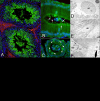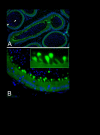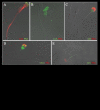Biomarker-based human and animal sperm phenotyping: the good, the bad and the ugly†
- PMID: 38640912
- PMCID: PMC11180624
- DOI: 10.1093/biolre/ioae061
Biomarker-based human and animal sperm phenotyping: the good, the bad and the ugly†
Abstract
Conventional, brightfield-microscopic semen analysis provides important baseline information about sperm quality of an individual; however, it falls short of identifying subtle subcellular and molecular defects in cohorts of "bad," defective human and animal spermatozoa with seemingly normal phenotypes. To bridge this gap, it is desirable to increase the precision of andrological evaluation in humans and livestock animals by pursuing advanced biomarker-based imaging methods. This review, spiced up with occasional classic movie references but seriously scholastic at the same time, focuses mainly on the biomarkers of altered male germ cell proteostasis resulting in post-testicular carryovers of proteins associated with ubiquitin-proteasome system. Also addressed are sperm redox homeostasis, epididymal sperm maturation, sperm-seminal plasma interactions, and sperm surface glycosylation. Zinc ion homeostasis-associated biomarkers and sperm-borne components, including the elements of neurodegenerative pathways such as Huntington and Alzheimer disease, are discussed. Such spectrum of biomarkers, imaged by highly specific vital fluorescent molecular probes, lectins, and antibodies, reveals both obvious and subtle defects of sperm chromatin, deoxyribonucleic acid, and accessory structures of the sperm head and tail. Introduction of next-generation image-based flow cytometry into research and clinical andrology will soon enable the incorporation of machine and deep learning algorithms with the end point of developing simple, label-free methods for clinical diagnostics and high-throughput phenotyping of spermatozoa in humans and economically important livestock animals.
Keywords: biomarker; fertility; phenomics; proteome; sperm.
© The Author(s) 2024. Published by Oxford University Press on behalf of Society for the Study of Reproduction.
Figures






Similar articles
-
Biomarker-based high-throughput sperm phenotyping: Andrology in the age of precision medicine and agriculture.Anim Reprod Sci. 2024 Dec;271:107636. doi: 10.1016/j.anireprosci.2024.107636. Epub 2024 Nov 8. Anim Reprod Sci. 2024. PMID: 39522272 Review.
-
Molecular markers of sperm quality.Soc Reprod Fertil Suppl. 2010;67:247-56. doi: 10.7313/upo9781907284991.021. Soc Reprod Fertil Suppl. 2010. PMID: 21755677 Review.
-
Negative biomarker based male fertility evaluation: Sperm phenotypes associated with molecular-level anomalies.Asian J Androl. 2015 Jul-Aug;17(4):554-60. doi: 10.4103/1008-682X.153847. Asian J Androl. 2015. PMID: 25999356 Free PMC article. Review.
-
New Approaches to Boar Semen Evaluation, Processing and Improvement.Reprod Domest Anim. 2015 Jul;50 Suppl 2:11-9. doi: 10.1111/rda.12554. Reprod Domest Anim. 2015. PMID: 26174914 Review.
-
Protein signatures of seminal plasma from bulls with contrasting frozen-thawed sperm viability.Sci Rep. 2020 Sep 4;10(1):14661. doi: 10.1038/s41598-020-71015-9. Sci Rep. 2020. PMID: 32887897 Free PMC article.
Cited by
-
Differential Activity and Expression of Proteasome in Seminiferous Epithelium During Mouse Spermatogenesis.Int J Mol Sci. 2025 Jan 9;26(2):494. doi: 10.3390/ijms26020494. Int J Mol Sci. 2025. PMID: 39859218 Free PMC article.
-
Sperm Membrane Stability: In-Depth Analysis from Structural Basis to Functional Regulation.Vet Sci. 2025 Jul 11;12(7):658. doi: 10.3390/vetsci12070658. Vet Sci. 2025. PMID: 40711318 Free PMC article. Review.
-
Exploring the full potential of sperm function with nanotechnology tools.Anim Reprod. 2024 Aug 16;21(3):e20240033. doi: 10.1590/1984-3143-AR2024-0033. eCollection 2024. Anim Reprod. 2024. PMID: 39176004 Free PMC article.
-
A time for sex: circadian regulation of mammalian sexual and reproductive function.Front Neurosci. 2025 Jan 6;18:1516767. doi: 10.3389/fnins.2024.1516767. eCollection 2024. Front Neurosci. 2025. PMID: 39834701 Free PMC article. Review.
References
-
- Sutovsky P, Oko R. Spermatozoa: the good, the bad and the ugly. Mol Reprod Dev 2011; 78:67. - PubMed
-
- Sutovsky P, Plummer W, Baska K, Peterman K, Diehl JR, Sutovsky M. Relative levels of semen platelet activating factor-receptor (PAFr) and ubiquitin in yearling bulls with high content of semen white blood cells: implications for breeding soundness evaluation. J Androl 2007; 28:92–108. - PubMed
-
- Kennedy CE, Krieger KB, Sutovsky M, Xu W, Vargovic P, Didion BA, Ellersieck MR, Hennessy ME, Verstegen J, Oko R, Sutovsky P. Protein expression pattern of PAWP in bull spermatozoa is associated with sperm quality and fertility following artificial insemination. Mol Reprod Dev 2014; 81:436–449. - PubMed
-
- Estop A, Catala V, Santalo J. Chromosome constitution of highly motile mouse sperm. Mol Reprod Dev 1990; 27:168–172. - PubMed
-
- Sutovsky P, Zelenkova N, Postlerova P, Zigo M. Proteostasis as a Sentry for Sperm Quality and Male Fertility. In: Chen CY (ed.), Molecular Male Reproductive Medicine: Biology and Clinical Perspectives. New York: Springer Nature; 2024.
Publication types
MeSH terms
Substances
Grants and funding
LinkOut - more resources
Full Text Sources
Research Materials
Miscellaneous

